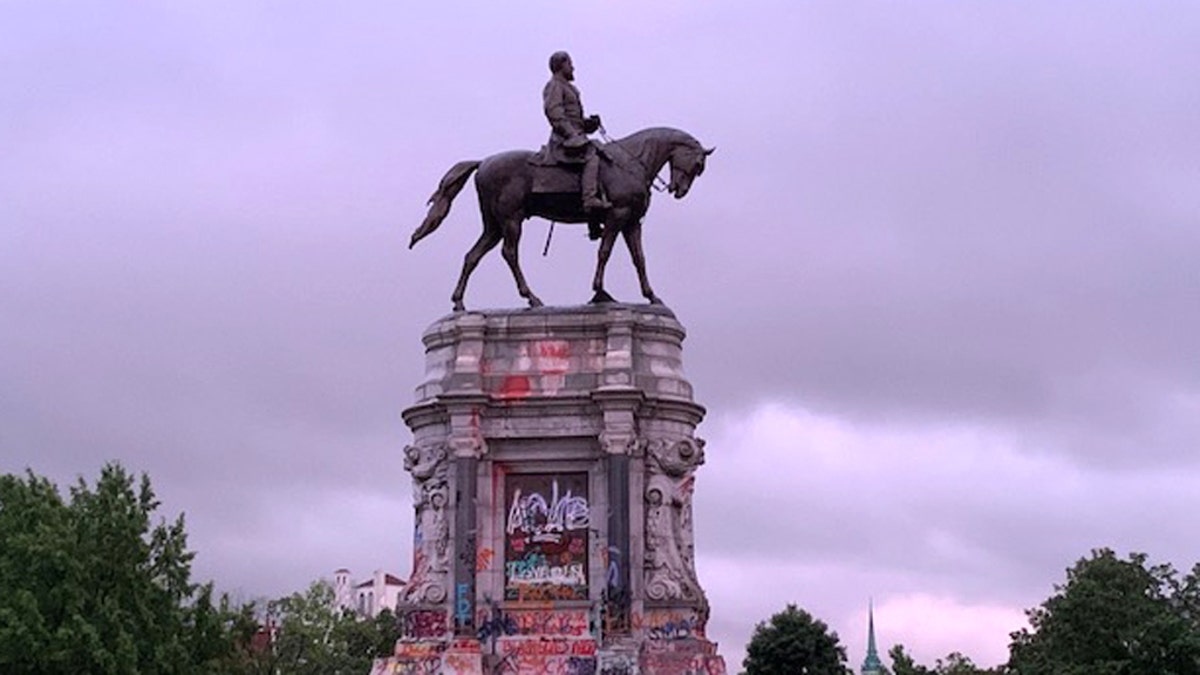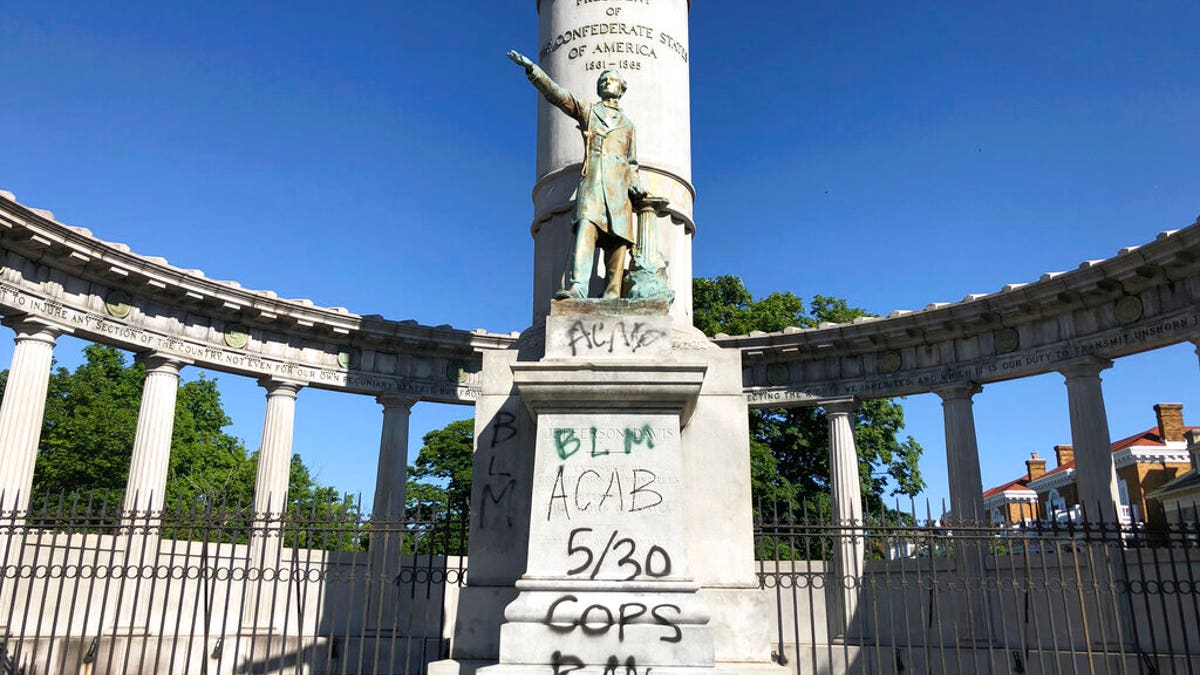Protesters attempt to destroy Confederate monument in Portsmouth, Virginia
Person seriously hurt as protesters tear down parts of Confederate monument in Portsmouth; Trace Gallagher reports.
RICHMOND, Va. — On a rainy Thursday evening in Richmond, Va., a 47-year-old man dressed in dark jeans and a black T-shirt with a white skull on the back knelt on the wet green grass on Monument Avenue and cried.
In front of him was the famed Robert E. Lee statue. The commander of the Confederate States Army had been immortalized in bronze riding a horse and had been in that exact same spot since May 28, 1890. According to local legend, it took 10,000 people to pull four wagons filled with pieces of the 60-foot statue to its resting place on the tree-lined street.
VIRGINIA GOVERNOR ANNOUNCES REMOVEL OF ROBERT E. LEE STATUE IN RICHMOND
Lee's statue, the first that went up on Monument Avenue, was supposed to be a strong historical symbol of the South's past but, over the decades, it has only deepened the racial divide in the former capital of the Confederacy.
Today, the base of the statue is covered in graffiti, some of it too filthy to describe. In front of the statue, there is a makeshift memorial to people of every color that have been affected by police brutality. A few of the memorials had flowers, trinkets and tealight candles in front of them.
"I'm not a racist," the man, who lives in Hopewell but did not want his name printed because he feared it would have an impact on his contracting business, told Fox News. "I love my country."
PROTESTERS TOPPLE CONFEDERATE STATUE IN VIRGINIA CAPITAL
A few feet down, 38-year-old Mike Maxwell looked up at the big, bronzed version of Lee.

Statue of Gen. Robert E. Lee on Monument Ave in Richmond, Va. (Barnini Chakraborty/Fox News)
"This statue has to go, son," he told his youngest child Nate, 5. "It's about racism and trying to suppress people like us. It's been here since I was a kid and I don't want you or your sister to have to look at it ever again."
Maxwell's comments represent a new wave of racial reckoning taking place across the country following the death of George Floyd, a black man who died after white police officer Derek Chauvin knelt on his neck for nearly nine minutes while he begged for his life.
Floyd's death, along with those of Ahmaud Arbery and Breonna Taylor, have given life to a movement that started with peaceful protests over police brutality and systemic racism but has morphed into something angrier.
Fueled by injustice and in some cases hate, the push to purge Confederate symbols across the state is gaining traction.
In Virginia, Democratic Gov. Ralph Northam announced on June 3 that he would order the removal of Lee's statue.
The move would be an extraordinary victory for civil rights activists who have been trying to get rid of it for years but had been met by a wall of resistance.
Del. Jay Jones, a black lawmaker from Norfolk, Va., said he was "overcome" by emotion when he learned Lee's statue was coming down.
"This is a symbol for so many people, black and others, of a time gone by of hate and oppression and being made to feel less than," he said.
VIRGINIA PROTESTS SEE 1 CRITICALLY INJURED IN SHOOTING, CONFEDERATE GROUP HQ TARGETED
Not everyone saw it that way.
State Sen. Amanda Chase, a 2021 gubernatorial candidate known locally for courting controversy, claimed "it's racially insensitive and racist in itself not to respect the history of all Americans. It's all about shoving this down people's throats and erasing the history of the white people."
She also shared a petition on Facebook to save the Lee statue, writing that "removing the Robert E. Lee statue is a cowardly capitulation to the looters and domestic terrorists."
Virginia Senate GOP leaders quickly denounced Chase's comments but said they supported keeping Lee's statue up.
"Attempts to eradicate instead of contextualizing history invariably fail," Senate GOP leaders wrote. "And because of this Governor's personal history, the motivations of this decision will always be suspect. Like Senator Chase's idiotic, inappropriate and inflammatory response, his decision is more likely further to divide, not unite, Virginians."

The base of the Gen. Robert E. Lee statute in Richmond, Va. is covered in graffiti. (Barnini Chakraborty/Fox News)
Northam began taking steps this week to take down Lee's statue — the only Confederate one on state property. However, late Monday a Circuit Court judge granted a temporary injunction to stop the removal for 10 days as part of a lawsuit filed by the descendant of a family who deeded the land. The suit challenges Northam's authority to take it down.
Impatient with the judicial process, protesters decided to take matters into their own hands, toppling Richmond's Jefferson Davis statue, located about half a mile from the statue of Lee.
Davis was pushed off his pedestal around 11 p.m. on Wednesday. His paint-splattered statue had fallen and was being dragged on the dirty road. City police quickly surrounded it and a tow truck showed up about a half-hour later to haul Davis away.

A monument to Confederate President Jefferson Davis in Richmond, Va., is covered with graffiti on Sunday, May 31, 2020, after overnight protests over the death of George Floyd. Many of the city’s most prominent Confederate monuments were tagged with similar graffiti. (AP)
According to local reports at the scene, as the statue was being loaded onto the tow truck, an onlooker said, "What a time to be alive! What a time to be in Richmond!"
Other bystanders shouted, "take it to the dump" and "throw it in the lake."
Davis isn't the only Confederate officer taken down.
On Saturday, a statue honoring Gen. Williams Carter Wickham was taken down in Richmond's Monroe Park, located about a mile away from Virginia's Capitol. And in Byrd Park, the first statue of Christopher Columbus to ever be put up in the American South, was also toppled by protesters.
CHRISTOPHER COLUMBUS STATUES TORN DOWN, DRENCHED IN PAINT, DEFACED IN CITIES ACROSS COUNTRY
In Portsmouth, Va., protesters knocked the heads off the statues of four Confederates and pulled one to the ground after the local city council scheduled a hearing on the monument's fate for the end of July. One protester was hit on the head and knocked unconscious as the statue fell.
James Boyd, the Portsmouth NAACP chapter president, said in a statement that "people are just tired of being sick and tired" and that the monument represents more than 400 years of oppression.
CLICK HERE FOR THE FOX NEWS APP
Back in Richmond, it's a lesson that Kristen Westerly is having trouble teaching her five boys.
"My family has lived in Richmond for a very long time and I'd be lying if I said I didn't understand why these monuments have to go but at the same time, they are part of history, of my history, of my family's history and I am having a real tough time with people that want to act like it never happened. It did. We should use it as a teaching tool."



